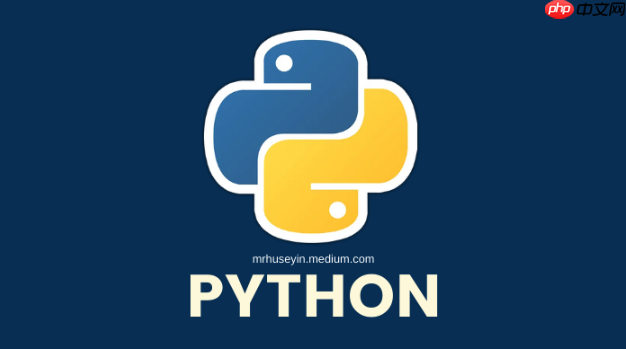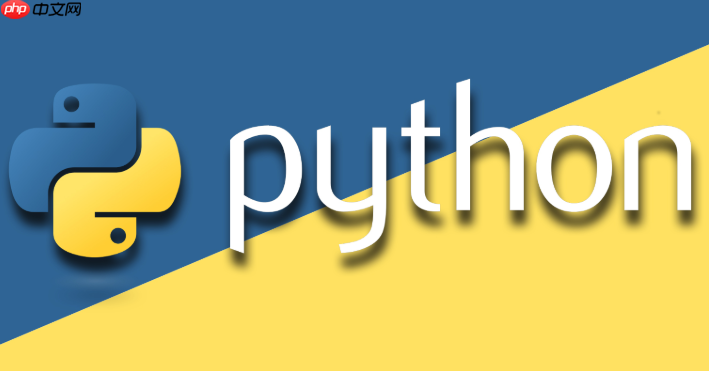else块在try-except-else-finally结构中的关键作用是:1. 提高代码清晰性,明确标识仅在try成功时执行的逻辑;2. 避免异常误捕获,防止将else中的错误与try中的异常混为一谈;3. 增强可读性,使try块聚焦潜在异常代码,else处理依赖成功执行的后续操作。例如在文件读取场景中,try负责打开和读取文件,except处理异常,else用于返回结果并确认成功,finally确保资源释放,从而实现职责分离、逻辑清晰的异常处理机制。

try-except-else-finally这几个关键词凑在一起,就像编程世界里的“人生百味”。 try是勇敢尝试,except是出错后的应对,else是没出错时的奖励,finally则是无论如何都要做的收尾。 容易被忽略的else块,其实是try成功后的“小确幸”,让代码逻辑更清晰。

解决方案

try-except-else-finally结构是Python中处理异常的强大工具,它们协同工作以确保代码的健壮性和可预测性。 理解它们的协同工作方式以及else块的关键作用至关重要。
工作流程:

try块: 首先执行try块中的代码。 这是你认为可能引发异常的代码区域。
except块: 如果try块中的代码引发了异常,Python会查找与该异常类型匹配的except块。 如果找到匹配的except块,则执行该块中的代码。 可以有多个except块来处理不同类型的异常。
else块: 只有当try块中的代码没有引发任何异常时,才会执行else块中的代码。 这是一个可选块。
finally块: 无论try块中的代码是否引发异常,finally块中的代码总是会被执行。 这通常用于清理资源,例如关闭文件或释放锁。
else块的关键作用:
else块的主要作用是在try块成功执行后执行代码。 这听起来很简单,但它有几个重要的优点:
else块中,可以使代码的意图更加清晰。 它明确地表明这些代码依赖于try块的成功完成。try块中,那么except块可能会捕获到你不希望捕获的异常。 例如,你可能只想捕获文件I/O异常,但如果try块中还有其他代码,except块也可能捕获到这些代码引发的异常。 else块可以避免这种情况。try块中的代码保持尽可能小,只包含可能引发异常的代码,可以提高代码的可读性。 将其他代码放在else块中可以使代码更易于理解。举例说明:
想象一下你要打开一个文件,读取其中的内容,然后关闭该文件。 你可以使用try-except-else-finally结构来处理可能出现的异常,例如文件不存在或无法读取。
def read_file(filename):
try:
f = open(filename, 'r')
data = f.read()
except FileNotFoundError:
print(f"Error: File '{filename}' not found.")
return None
except IOError:
print(f"Error: Could not read file '{filename}'.")
return None
else:
print(f"File '{filename}' read successfully.")
return data
finally:
if 'f' in locals() and hasattr(f, 'close'): # 确保文件对象存在且有close方法
f.close()
print(f"File '{filename}' closed.")
# 使用示例
content = read_file("my_file.txt")
if content:
print("File content:", content)在这个例子中:
try块尝试打开和读取文件。except块处理FileNotFoundError和IOError异常。else块在文件成功读取后打印一条消息并返回文件内容。finally块确保文件被关闭,即使发生异常。嵌套的try-except-else-finally块意味着在一个try块内部包含另一个try-except-else-finally结构。 这种结构用于处理更复杂的情况,其中内部操作可能引发需要与外部操作分开处理的异常。
基本原则:
try块都与其相关的except、else和finally块独立工作。try块引发异常,则首先由内部except块处理。 如果内部except块无法处理该异常,则该异常会传播到外部try块。finally块始终在控制权传递给外部块之前执行。示例:
假设你需要读取一个配置文件,该文件包含另一个文件的路径。 你可以使用嵌套的try块来处理读取配置文件和读取嵌套文件时可能出现的异常。
def read_nested_file(config_file):
try:
# 读取配置文件
with open(config_file, 'r') as f:
nested_file_path = f.readline().strip()
try:
# 读取嵌套文件
with open(nested_file_path, 'r') as nested_f:
nested_content = nested_f.read()
except FileNotFoundError:
print(f"Error: Nested file '{nested_file_path}' not found.")
return None
except IOError:
print(f"Error: Could not read nested file '{nested_file_path}'.")
return None
else:
print(f"Nested file '{nested_file_path}' read successfully.")
return nested_content
finally:
print("Inner finally block executed.")
except FileNotFoundError:
print(f"Error: Config file '{config_file}' not found.")
return None
except IOError:
print(f"Error: Could not read config file '{config_file}'.")
return None
else:
print(f"Config file '{config_file}' read successfully.")
finally:
print("Outer finally block executed.")
# 使用示例
nested_file_content = read_nested_file("config.txt")
if nested_file_content:
print("Nested file content:", nested_file_content)在这个例子中:
try块处理读取配置文件的异常。try块处理读取嵌套文件的异常。except块会捕获FileNotFoundError异常并打印一条消息。finally块都会执行。except块会捕获FileNotFoundError异常并打印一条消息。finally块都会执行。关键注意事项:
try块传播到外部try块至关重要。finally块的执行顺序: 内部finally块始终在外部finally块之前执行。try块会降低代码的可读性。 尽量保持嵌套层级尽可能低,并使用清晰的变量名和注释来解释代码的意图。在多线程环境中使用try-except-else-finally需要特别小心,因为异常处理可能会影响线程的执行流程和资源管理。
挑战:
try、except、else和finally块中访问的任何共享资源都是线程安全的。 这可能需要使用锁或其他同步机制。最佳实践:
在每个线程中使用try-except-finally: 确保每个线程都有自己的try-except-finally块,以便捕获和处理该线程中可能发生的任何异常。
使用队列进行线程间通信: 如果需要在线程之间传递异常信息,可以使用队列。 一个线程可以捕获异常并将异常信息放入队列中,另一个线程可以从队列中读取异常信息并进行处理。
使用threading.Lock进行资源同步: 如果多个线程需要访问共享资源,请使用threading.Lock或其他同步机制来确保线程安全。 在try块中获取锁,并在finally块中释放锁。
使用logging模块记录异常: 使用logging模块记录所有异常信息,以便进行调试和故障排除。
示例:
import threading
import time
import logging
logging.basicConfig(level=logging.DEBUG,
format='(%(threadName)-9s) %(message)s',)
class Worker(threading.Thread):
def __init__(self, lock, filename):
super().__init__()
self.lock = lock
self.filename = filename
def run(self):
logging.debug('Starting')
try:
with self.lock:
logging.debug('Lock acquired')
with open(self.filename, 'w') as f:
f.write("Hello, world!\n")
time.sleep(2) # 模拟一些耗时操作
raise ValueError("Simulated error") # 模拟错误
except FileNotFoundError:
logging.error(f"File '{self.filename}' not found.")
except ValueError as e:
logging.error(f"ValueError: {e}")
except Exception as e:
logging.error(f"An unexpected error occurred: {e}")
finally:
if self.lock.locked():
self.lock.release()
logging.debug('Lock released')
logging.debug('Finishing')
# 创建一个锁
lock = threading.Lock()
# 创建并启动线程
worker1 = Worker(lock, "file1.txt")
worker2 = Worker(lock, "file1.txt") # 故意使用相同的文件名,模拟资源竞争
worker1.start()
worker2.start()
worker1.join()
worker2.join()
logging.debug('All done')在这个例子中:
Worker线程都有自己的try-except-finally块来处理可能发生的异常。threading.Lock来确保对文件的访问是线程安全的。try块中获取锁,并在finally块中释放锁。logging模块记录所有异常信息。总结:
在多线程环境中使用try-except-else-finally需要仔细考虑线程安全和资源管理。 通过遵循上述最佳实践,你可以确保你的代码能够正确处理异常,即使在并发环境中也能正常运行。
虽然else块看起来像是多余的,因为它执行的代码也可以直接放在try块之后,但它们之间存在微妙但重要的区别,这影响了代码的可读性、可维护性和异常处理的精确性。
主要区别:
else块中的代码不会被try块中的except块捕获。 这意味着else块中的异常不会被误认为是try块中代码引起的异常。else块明确地表明其中的代码只有在try块成功完成时才应该执行。 这提高了代码的可读性,使代码的意图更加清晰。try块中,except块可能会捕获到你不希望捕获的异常。 else块可以避免这种情况,因为它将只在没有异常时执行。详细解释:
想象一下以下两种情况:
情况 1:没有 else 块
def process_data(data):
try:
# 步骤 1: 验证数据
validated_data = validate(data)
# 步骤 2: 处理数据 (只有在数据验证成功后才应该执行)
result = process(validated_data)
# 步骤 3: 保存结果
save_result(result)
except ValidationError as e:
print(f"Validation error: {e}")
except ProcessingError as e:
print(f"Processing error: {e}")
except Exception as e:
print(f"An unexpected error occurred: {e}")
finally:
print("Cleanup operations")在这个例子中,process和save_result函数中的任何异常都会被except Exception as e捕获,这可能不是我们想要的。 我们可能希望只捕获validate函数中的特定异常。
情况 2:使用 else 块
def process_data(data):
try:
# 步骤 1: 验证数据
validated_data = validate(data)
except ValidationError as e:
print(f"Validation error: {e}")
except Exception as e:
print(f"An unexpected error occurred during validation: {e}") # 更具体的错误信息
else:
try:
# 步骤 2: 处理数据 (只有在数据验证成功后才应该执行)
result = process(validated_data)
# 步骤 3: 保存结果
save_result(result)
except ProcessingError as e:
print(f"Processing error: {e}")
except Exception as e:
print(f"An unexpected error occurred during processing or saving: {e}") # 更具体的错误信息
finally:
print("Cleanup operations")在这个例子中,else块中的代码只会在validate函数没有引发任何异常时执行。 如果process或save_result函数引发异常,它们将被不同的except块捕获,并且我们可以提供更具体的错误信息。 此外,如果validate函数引发异常,else块中的代码将不会执行。
总结:
使用else块可以提高代码的可读性、可维护性和异常处理的精确性。 它明确地表明其中的代码只有在try块成功完成时才应该执行,并且可以避免过度捕获异常。 虽然在简单的情况下,直接在try块后编写代码可能看起来更简洁,但在更复杂的情况下,使用else块通常是更好的选择。
以上就是try-except-else-finally如何协同工作?else块容易被忽略的关键作用是什么?的详细内容,更多请关注php中文网其它相关文章!

每个人都需要一台速度更快、更稳定的 PC。随着时间的推移,垃圾文件、旧注册表数据和不必要的后台进程会占用资源并降低性能。幸运的是,许多工具可以让 Windows 保持平稳运行。




Copyright 2014-2025 https://www.php.cn/ All Rights Reserved | php.cn | 湘ICP备2023035733号